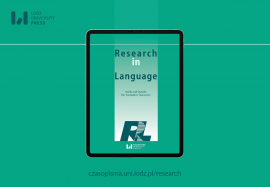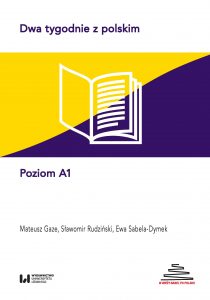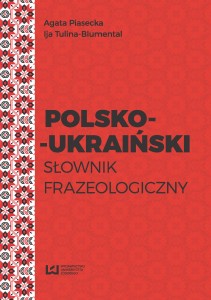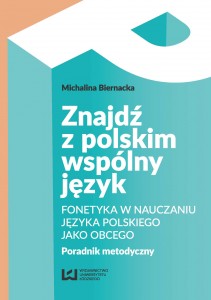Research in Language | Vol. 20, Nr 3 i 4
Opublikowano: 30 czerwca 2023

Zapraszamy do lektury dwóch nowych numerów czasopisma naukowego Research in Language. Kwartalnik publikuje artykuły badawcze i recenzje książek z zakresu fonetyki, fonologii, morfologii, składni, semantyki i pragmatyki, ale także przedstawiające wyniki badań różnorodnych aspektów języka: poznawczego, psychologicznego, instytucjonalnego czy społecznego, prowadzonych wielowymiarowo i interdyscyplinarnie.
Language and Music: Designing a Course at an Academic Level
Anna Gralińska-Brawata
The parallels that are present between language and music, together with popular beliefs that musicality may be a factor enhancing language learning, especially with regard to pronunciation, prompted the idea of designing an academic course whose main aim was to demonstrate the relation between the two domains from the linguistic perspective. There were eighteen students participating in the course which was an elective for 1st year MA students of English at the University of Łódź. The course content included presentation of direct links between language and music, and of selected studies indicating the influence of music on developing various aspects of linguistic performance, e.g. second language learning (e.g. Pastuszek-Lipińska, 2008; Kolinsky et al., 2009), early reading abilities (Fonseca-Mora et al., 2018) or pitch processing (Besson et al., 2007). The practical part of the course involved testing the students’ musical abilities with the use of various tools: tests available online and a sample of a music school entrance exam (based on Rybińska et al., 2016). The participants completed tasks related to their English speech performance, i.e. recording the passage The North Wind and the Sun and analysing their English speech production with the use of acoustic speech analysis software (Praat) in order to learn about the ways in which they could explore the possible links between their musicality and performance in L2 English. The majority of students claimed that they had not been aware of the degree of interplay between language and music, and had overestimated their musical abilities prior to taking the tests, but they saw the potential of music training not only in language learning, but other spheres of human activity.
Gendered Neologisms Beyond Social Media: the Current Use of “Mansplaining”
Maria Szymańska
The word mansplaining, which is a linguistic blend of man and explaining, is one of the examples of a trend in the English language of creating gendered neologisms – blends and compounds that add an aspect of gender to the meaning of already existing words that originally are gender-neutral (or appear to be). So far, the linguistic research on this phenomenon has focused on analysing them in informal context of social media (see Bridges 2017, Lutzky and Lawson 2019) or crowd-sourced dictionaries (see Foubert and Lemmens 2018). Nonetheless, with the growing popularity, some gendered neologisms, including mansplaining, start being used in outside social media, in more formal contexts. This study presents the place of mansplaining in the current linguistic landscape through looking at its definitions presented in traditional dictionaries and how it is used outside of social media – in what grammatical forms and in what contexts.
Investigating Rater Perceptions in the Assessment of Speaking
Przemysław Krakowian
In the assessment of spoken production, numerous reasons can be identified behind the decisions that raters make in evaluating samples of oral performance. Inter and intra rater factors are relatively well documented in various reliability and validity studies. Some that have been identified in literature involve the effects of examinee pairing or the familiarity with the examinees, others point in the direction of gender and gender role perceptions O’Sullivan (2008), others appear to be connected with body language and non-verbal cues that accompany oral production (cf.: Krahmer and Swerts 2004, Seiter, Weger, Jensen and Kinzer 2010). While some studies that address the assessment of speaking English in exam contexts suggest that raters may not feel as comfortable assessing pronunciation as they do other aspects of a speaker’s performance (Orr 2002, Hubbard, Gilbert and Pidcock 2006, Brown 2006, De Velle 2008), more recent investigations of rater behaviour involving electronic evidence from training, maintenance and online examination programmes tentatively show that pronunciation, in fact, is the first category examiners attend to (Hubbard 2011, Chambers and Ingham 2011, Krakowian 2011, Seed 2012, Tynan 2015, Kang and Ginther 2019). This paper looks at large collection of assessments stored in an electronic system to investigate what raters really seem to pay attention to when allegedly following rating scales.
What every EFL Instructor Needs to Know: Effective Implementation of Needs Analysis
Olga Trendak-Suślik
One of the first issues that any foreign language teacher needs to take into consideration prior to commencing on their language course is the implementation of a comprehensive learner needs analysis (NA) also referred to as needs assessment. Garnering information on, among others, students’ learning preferences, their previous learning experience or their goals is pivotal in order to design a course that would cater to students’ different needs and meet their expectations. A one-size-fits-all approach is not in line with the reality of language teaching in the 21st century, hence the need for the introduction of NA during language classes.
The aim of the following article is to explore the area of needs analysis – examine its beginnings and further development; define its basic components and also investigate the different data-collection instruments language teachers have at their disposal. The article will also present the results of a pilot study exploring Polish teachers’ perspectives on the introduction of needs analysis in the foreign language classroom.
Editorial to Research in Language (RiL) Vol.30, issue
Przemysław Krakowian
From Crystal-clear to Limpide: Translating English [Noun+adj] Compound Adjectives with a Figurative-intensifying Noun into French
Thomas Prinzie, Ferran Suñer, Kristel Van Goethem
English [Noun+Adj] compound adjectives containing an intensifying metaphor (e.g. crystal-clear) pose particular challenges for French translation, due in part to the absence of a direct equivalent construction. Our study examines morphosyntactic and conceptual-semantic translation procedures that capture how these challenges are resolved. We also explore the little-investigated aspect of translation variation (the number of different solutions for each item). We analyze the potential effects of two factors: the presence or absence of figurative intensification and the items’ frequency of use in English. Our results indicate that translators prefer different morphosyntactic procedures for different compound subtypes. Overall, an adjective constituent is most frequently retained, although complete reformulations with a noun or verb also occur. Semantically, the intensifying meaning is often rendered non-figuratively, depending on what is available in idiomatic French usage. Intensification is also frequently dropped. Translation variation is remarkably high, due in part to extensive use of near-synonyms. High-frequency items do not appear to converge on a smaller number of translations, but instead provide more opportunities for diversification.
Decoding Terminological AWARENESS: Developing Terminological Competence
Marina Platonova
In the dynamically changing scientific and academic environment it is rather difficult to imagine efficient communication among professionals in any field and across domains unless terminological deficiencies are properly addressed and solved. Bridging the existing terminological gap implies considering the issues of availability of terms, terminological work, acceptability of terms, responsibility of the respective authorities, degree of erudition of the actors, the performed needs analysis, term elaboration mechanisms, sensitivity and tolerance of the stakeholders, and last but not least, a well-defined scientific approach to term creation, harmonization and alignment across the languages.
Therefore, raising terminological awareness is an essential part of curriculum at all levels of tertiary education, fundamental and/or applied research as well as vocational traineeship. It especially concerns the design of the contemporary technical translator profile, developing terminological competence and addressing the issues of cultural sensitivity and domain knowledge.
The present paper aims at discussing the notion of terminological awareness and testing it against the number of the relevant terminological sub-competences a user should possess.
The influence of Latin on Old English adjectival postposition
Maciej Grabski
The article is a systematic, corpus-based account of Latin’s influence on the position of Old English (OE) adnominal adjectives. While multiple studies on phrase-level syntax suggest that source-text interference may have been partly responsible for placing the adjective after the head noun, this observation has so far received little quantitative underpinning. The present article offers a detailed comparison of OE target noun phrases containing postnominal adjectives with their Latin counterparts to determine the exact extent to which this arrangement may have been a syntactic calque from a foreign language. The study has found that while a fair number of OE postposed adjectives did copy their Latin originals, their placement could be accounted for through reference to tendencies characteristic of OE (i.e. the adjective displays different degrees of “verbalness” or is part of a heavy phrase). Therefore, it appears that translated texts do not have to be excluded or treated with particular suspicion in studies concerned with the position of adnominal adjectives.
Acculturation Strategy and its Influence on the use of Rhoticity by Polish Adult Immigrants to Wales
Aleksandra Matysiak
Migration to a foreign country can be a complex process involving the adjustment to a new culture and the acquisition of a second language (L2). Acculturation, the process by which an individual integrates their native values and behaviours with those of the host culture, is an integral part of this process. It has been suggested that the choice of acculturation strategy can either facilitate or hinder L2 acquisition (Schumann, 1986; Berry, 1997). Pronunciation is a vital aspect of L2 proficiency and is often seen as mediating an individual’s identity in the host culture (Piske et al., 2001). This study focuses on the pronunciation patterns of ten adult Polish immigrants living in Welshpool, Wales, and attempts to examine the potential relationship between a chosen acculturation strategy (adaptation or preservation) and the use of rhoticity in English. Rhoticity, a salient feature of British English pronunciation that varies in use and quality depending on the region (Wells, 1982), has been previously studied in relation to the use of rhoticity by Polish speakers (Jaworski, 2010; Jaworski & Gillian, 2011; Stolarski, 2013, 2015; Zając, 2016; Rojczyk & Zając, 2017; Matysiak, 2020), with a notable emphasis on the use of taps in intervocalic and post-vocalic positions. The present study found some inconsistencies in the use of rhoticity in English.
Komentarze
Ten post dostępny jest także w języku: angielski





